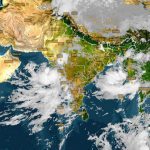Hours before a strong cyclone is predicted to batter the low-lying area, authorities have reported that at least 1.1 million residents on India’s eastern coast are evacuating to storm shelters inland.
According to India’s weather agency, Cyclone Dana is expected to make landfall as a “severe cyclonic storm” late Thursday around the shores of West Bengal and Odisha states, which are home to some 150 million people. Winds of up to 120 kilometers per hour (74 mph) are predicted.
Major airports will close overnight, including Kolkata, a major transport hub where torrential rain was already battering the expansive metropolis.
The storm’s eye is expected to land early Friday, some 230 kilometers (140 miles) southwest of the megacity of Kolkata, close to the port of Dhamara, which exports coal.
It is also anticipated to affect Bangladesh, a low-lying neighbor, where “extensive preparations” are being made, according to Muhammad Yunus, the leader of the interim government.

Large tracts of coastal areas are projected to be submerged by crashing waves, with water levels rising up to two meters (6.5 feet) above normal tide levels.
Odisha state health minister Mukesh Mahaling said that “nearly a million people from the coastal areas are being evacuated to cyclone centres”.
In neighbouring West Bengal state, government minister Bankim Chandra Hazra said “More than 100,000 people have so far been shifted to safer places”.
Businesses in Puri, a popular beach resort, have been ordered to close, and tourists told to leave.
Kolkata airport director Pravat Ranjan Beuria said the airport will suspend flights overnight on Thursday due to “predicted heavy winds and heavy to very heavy rainfall”.
The airport in the city of Bhubaneshwar will do the same, while scores of trains have been cancelled, and ferries from Kolkata ordered to stay in port.
Cyclones – the equivalent of hurricanes in the North Atlantic or typhoons in the Northwestern Pacific – are a regular and deadly menace in the northern Indian Ocean.
Scientists have warned that storms are becoming more powerful as the world gets warmer with climate change.
Hours before a strong cyclone is predicted to batter the low-lying area, authorities have reported that at least 1.1 million residents on India’s eastern coast are evacuating to storm shelters inland.
According to India’s weather agency, Cyclone Dana is expected to make landfall as a “severe cyclonic storm” late Thursday around the shores of West Bengal and Odisha states, which are home to some 150 million people. Winds of up to 120 kilometers per hour (74 mph) are predicted.
Major airports will close overnight, including Kolkata, a major transport hub where torrential rain was already battering the expansive metropolis.
The storm’s eye is expected to land early Friday, some 230 kilometers (140 miles) southwest of the megacity of Kolkata, close to the port of Dhamara, which exports coal.
It is also anticipated to affect Bangladesh, a low-lying neighbor, where “extensive preparations” are being made, according to Muhammad Yunus, the leader of the interim government.

Large tracts of coastal areas are projected to be submerged by crashing waves, with water levels rising up to two meters (6.5 feet) above normal tide levels.
Odisha state health minister Mukesh Mahaling said that “nearly a million people from the coastal areas are being evacuated to cyclone centres”.
In neighbouring West Bengal state, government minister Bankim Chandra Hazra said “More than 100,000 people have so far been shifted to safer places”.
Businesses in Puri, a popular beach resort, have been ordered to close, and tourists told to leave.
Kolkata airport director Pravat Ranjan Beuria said the airport will suspend flights overnight on Thursday due to “predicted heavy winds and heavy to very heavy rainfall”.
The airport in the city of Bhubaneshwar will do the same, while scores of trains have been cancelled, and ferries from Kolkata ordered to stay in port.
Cyclones – the equivalent of hurricanes in the North Atlantic or typhoons in the Northwestern Pacific – are a regular and deadly menace in the northern Indian Ocean.
Scientists have warned that storms are becoming more powerful as the world gets warmer with climate change.
Hours before a strong cyclone is predicted to batter the low-lying area, authorities have reported that at least 1.1 million residents on India’s eastern coast are evacuating to storm shelters inland.
According to India’s weather agency, Cyclone Dana is expected to make landfall as a “severe cyclonic storm” late Thursday around the shores of West Bengal and Odisha states, which are home to some 150 million people. Winds of up to 120 kilometers per hour (74 mph) are predicted.
Major airports will close overnight, including Kolkata, a major transport hub where torrential rain was already battering the expansive metropolis.
The storm’s eye is expected to land early Friday, some 230 kilometers (140 miles) southwest of the megacity of Kolkata, close to the port of Dhamara, which exports coal.
It is also anticipated to affect Bangladesh, a low-lying neighbor, where “extensive preparations” are being made, according to Muhammad Yunus, the leader of the interim government.

Large tracts of coastal areas are projected to be submerged by crashing waves, with water levels rising up to two meters (6.5 feet) above normal tide levels.
Odisha state health minister Mukesh Mahaling said that “nearly a million people from the coastal areas are being evacuated to cyclone centres”.
In neighbouring West Bengal state, government minister Bankim Chandra Hazra said “More than 100,000 people have so far been shifted to safer places”.
Businesses in Puri, a popular beach resort, have been ordered to close, and tourists told to leave.
Kolkata airport director Pravat Ranjan Beuria said the airport will suspend flights overnight on Thursday due to “predicted heavy winds and heavy to very heavy rainfall”.
The airport in the city of Bhubaneshwar will do the same, while scores of trains have been cancelled, and ferries from Kolkata ordered to stay in port.
Cyclones – the equivalent of hurricanes in the North Atlantic or typhoons in the Northwestern Pacific – are a regular and deadly menace in the northern Indian Ocean.
Scientists have warned that storms are becoming more powerful as the world gets warmer with climate change.
Hours before a strong cyclone is predicted to batter the low-lying area, authorities have reported that at least 1.1 million residents on India’s eastern coast are evacuating to storm shelters inland.
According to India’s weather agency, Cyclone Dana is expected to make landfall as a “severe cyclonic storm” late Thursday around the shores of West Bengal and Odisha states, which are home to some 150 million people. Winds of up to 120 kilometers per hour (74 mph) are predicted.
Major airports will close overnight, including Kolkata, a major transport hub where torrential rain was already battering the expansive metropolis.
The storm’s eye is expected to land early Friday, some 230 kilometers (140 miles) southwest of the megacity of Kolkata, close to the port of Dhamara, which exports coal.
It is also anticipated to affect Bangladesh, a low-lying neighbor, where “extensive preparations” are being made, according to Muhammad Yunus, the leader of the interim government.

Large tracts of coastal areas are projected to be submerged by crashing waves, with water levels rising up to two meters (6.5 feet) above normal tide levels.
Odisha state health minister Mukesh Mahaling said that “nearly a million people from the coastal areas are being evacuated to cyclone centres”.
In neighbouring West Bengal state, government minister Bankim Chandra Hazra said “More than 100,000 people have so far been shifted to safer places”.
Businesses in Puri, a popular beach resort, have been ordered to close, and tourists told to leave.
Kolkata airport director Pravat Ranjan Beuria said the airport will suspend flights overnight on Thursday due to “predicted heavy winds and heavy to very heavy rainfall”.
The airport in the city of Bhubaneshwar will do the same, while scores of trains have been cancelled, and ferries from Kolkata ordered to stay in port.
Cyclones – the equivalent of hurricanes in the North Atlantic or typhoons in the Northwestern Pacific – are a regular and deadly menace in the northern Indian Ocean.
Scientists have warned that storms are becoming more powerful as the world gets warmer with climate change.
Hours before a strong cyclone is predicted to batter the low-lying area, authorities have reported that at least 1.1 million residents on India’s eastern coast are evacuating to storm shelters inland.
According to India’s weather agency, Cyclone Dana is expected to make landfall as a “severe cyclonic storm” late Thursday around the shores of West Bengal and Odisha states, which are home to some 150 million people. Winds of up to 120 kilometers per hour (74 mph) are predicted.
Major airports will close overnight, including Kolkata, a major transport hub where torrential rain was already battering the expansive metropolis.
The storm’s eye is expected to land early Friday, some 230 kilometers (140 miles) southwest of the megacity of Kolkata, close to the port of Dhamara, which exports coal.
It is also anticipated to affect Bangladesh, a low-lying neighbor, where “extensive preparations” are being made, according to Muhammad Yunus, the leader of the interim government.

Large tracts of coastal areas are projected to be submerged by crashing waves, with water levels rising up to two meters (6.5 feet) above normal tide levels.
Odisha state health minister Mukesh Mahaling said that “nearly a million people from the coastal areas are being evacuated to cyclone centres”.
In neighbouring West Bengal state, government minister Bankim Chandra Hazra said “More than 100,000 people have so far been shifted to safer places”.
Businesses in Puri, a popular beach resort, have been ordered to close, and tourists told to leave.
Kolkata airport director Pravat Ranjan Beuria said the airport will suspend flights overnight on Thursday due to “predicted heavy winds and heavy to very heavy rainfall”.
The airport in the city of Bhubaneshwar will do the same, while scores of trains have been cancelled, and ferries from Kolkata ordered to stay in port.
Cyclones – the equivalent of hurricanes in the North Atlantic or typhoons in the Northwestern Pacific – are a regular and deadly menace in the northern Indian Ocean.
Scientists have warned that storms are becoming more powerful as the world gets warmer with climate change.
Hours before a strong cyclone is predicted to batter the low-lying area, authorities have reported that at least 1.1 million residents on India’s eastern coast are evacuating to storm shelters inland.
According to India’s weather agency, Cyclone Dana is expected to make landfall as a “severe cyclonic storm” late Thursday around the shores of West Bengal and Odisha states, which are home to some 150 million people. Winds of up to 120 kilometers per hour (74 mph) are predicted.
Major airports will close overnight, including Kolkata, a major transport hub where torrential rain was already battering the expansive metropolis.
The storm’s eye is expected to land early Friday, some 230 kilometers (140 miles) southwest of the megacity of Kolkata, close to the port of Dhamara, which exports coal.
It is also anticipated to affect Bangladesh, a low-lying neighbor, where “extensive preparations” are being made, according to Muhammad Yunus, the leader of the interim government.

Large tracts of coastal areas are projected to be submerged by crashing waves, with water levels rising up to two meters (6.5 feet) above normal tide levels.
Odisha state health minister Mukesh Mahaling said that “nearly a million people from the coastal areas are being evacuated to cyclone centres”.
In neighbouring West Bengal state, government minister Bankim Chandra Hazra said “More than 100,000 people have so far been shifted to safer places”.
Businesses in Puri, a popular beach resort, have been ordered to close, and tourists told to leave.
Kolkata airport director Pravat Ranjan Beuria said the airport will suspend flights overnight on Thursday due to “predicted heavy winds and heavy to very heavy rainfall”.
The airport in the city of Bhubaneshwar will do the same, while scores of trains have been cancelled, and ferries from Kolkata ordered to stay in port.
Cyclones – the equivalent of hurricanes in the North Atlantic or typhoons in the Northwestern Pacific – are a regular and deadly menace in the northern Indian Ocean.
Scientists have warned that storms are becoming more powerful as the world gets warmer with climate change.
Hours before a strong cyclone is predicted to batter the low-lying area, authorities have reported that at least 1.1 million residents on India’s eastern coast are evacuating to storm shelters inland.
According to India’s weather agency, Cyclone Dana is expected to make landfall as a “severe cyclonic storm” late Thursday around the shores of West Bengal and Odisha states, which are home to some 150 million people. Winds of up to 120 kilometers per hour (74 mph) are predicted.
Major airports will close overnight, including Kolkata, a major transport hub where torrential rain was already battering the expansive metropolis.
The storm’s eye is expected to land early Friday, some 230 kilometers (140 miles) southwest of the megacity of Kolkata, close to the port of Dhamara, which exports coal.
It is also anticipated to affect Bangladesh, a low-lying neighbor, where “extensive preparations” are being made, according to Muhammad Yunus, the leader of the interim government.

Large tracts of coastal areas are projected to be submerged by crashing waves, with water levels rising up to two meters (6.5 feet) above normal tide levels.
Odisha state health minister Mukesh Mahaling said that “nearly a million people from the coastal areas are being evacuated to cyclone centres”.
In neighbouring West Bengal state, government minister Bankim Chandra Hazra said “More than 100,000 people have so far been shifted to safer places”.
Businesses in Puri, a popular beach resort, have been ordered to close, and tourists told to leave.
Kolkata airport director Pravat Ranjan Beuria said the airport will suspend flights overnight on Thursday due to “predicted heavy winds and heavy to very heavy rainfall”.
The airport in the city of Bhubaneshwar will do the same, while scores of trains have been cancelled, and ferries from Kolkata ordered to stay in port.
Cyclones – the equivalent of hurricanes in the North Atlantic or typhoons in the Northwestern Pacific – are a regular and deadly menace in the northern Indian Ocean.
Scientists have warned that storms are becoming more powerful as the world gets warmer with climate change.
Hours before a strong cyclone is predicted to batter the low-lying area, authorities have reported that at least 1.1 million residents on India’s eastern coast are evacuating to storm shelters inland.
According to India’s weather agency, Cyclone Dana is expected to make landfall as a “severe cyclonic storm” late Thursday around the shores of West Bengal and Odisha states, which are home to some 150 million people. Winds of up to 120 kilometers per hour (74 mph) are predicted.
Major airports will close overnight, including Kolkata, a major transport hub where torrential rain was already battering the expansive metropolis.
The storm’s eye is expected to land early Friday, some 230 kilometers (140 miles) southwest of the megacity of Kolkata, close to the port of Dhamara, which exports coal.
It is also anticipated to affect Bangladesh, a low-lying neighbor, where “extensive preparations” are being made, according to Muhammad Yunus, the leader of the interim government.

Large tracts of coastal areas are projected to be submerged by crashing waves, with water levels rising up to two meters (6.5 feet) above normal tide levels.
Odisha state health minister Mukesh Mahaling said that “nearly a million people from the coastal areas are being evacuated to cyclone centres”.
In neighbouring West Bengal state, government minister Bankim Chandra Hazra said “More than 100,000 people have so far been shifted to safer places”.
Businesses in Puri, a popular beach resort, have been ordered to close, and tourists told to leave.
Kolkata airport director Pravat Ranjan Beuria said the airport will suspend flights overnight on Thursday due to “predicted heavy winds and heavy to very heavy rainfall”.
The airport in the city of Bhubaneshwar will do the same, while scores of trains have been cancelled, and ferries from Kolkata ordered to stay in port.
Cyclones – the equivalent of hurricanes in the North Atlantic or typhoons in the Northwestern Pacific – are a regular and deadly menace in the northern Indian Ocean.
Scientists have warned that storms are becoming more powerful as the world gets warmer with climate change.














